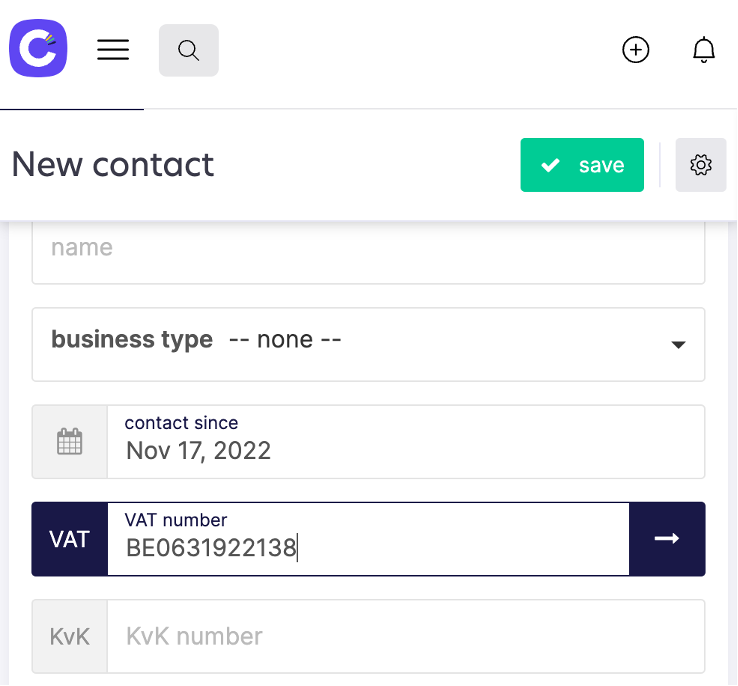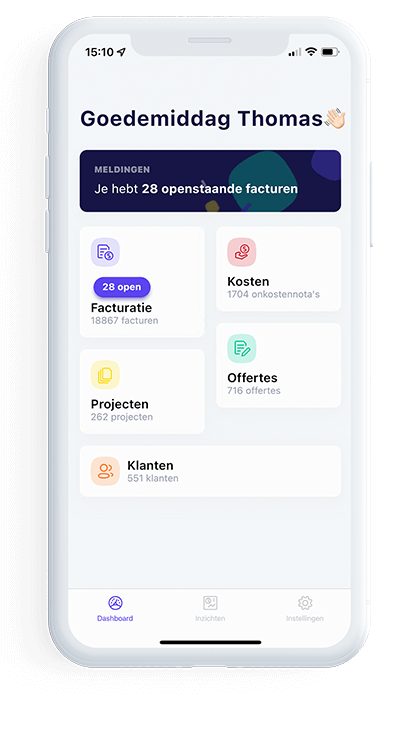
A cool freelancer time tracking tool
Are you a freelancer charging clients an hourly rate? Then, you definitely need an accurate time tracking tool. But even if you use a different revenue model, your freelance business can profit from simple time tracking software. Read on to find out how...
Key takeaways
Hourly billing, or an hourly invoice, has advantages for both freelancers and customers.
Time tracking is more than registering how many billable hours you have worked.
All freelancers benefit from registering and analysing their working time.
Time registration isn’t rocket science. But a good time tracking system contains a minimum set of features.
A decent timesheet tool will make your administration a breeze.
The hourly billing model
Hourly billing is the most popular billing model amongst freelancers. It’s also a simple one: you offer a particular skill, or sell your know-how to organisations and charge them a fee per hour.
The more hours you work for a customer, the more you can earn.
This is a transparent earning model, and that’s the reason it works well for both parties.
Advantages for freelancers of hourly billing
As a freelancer, the hourly billing model comes with a set of advantages.
You don't need to do complicated calculations to create an offer. Determine your hourly rate and multiply it by the hours you worked for a client.
If a customer hires you for a longer period, your income will be predictable. Security is one of those things that sound like a luxury for the majority of freelancers.
For smaller assignments, you can charge a flat fee. There is really no need to register (and charge) every second you lift a finger.
You can easily adjust your hourly rate to your client, the type of assignment, or even the period for which you are hired. An hourly rate leaves room for flexibility.
Hourly billing is brilliant because both parties profit from it
Advantages of hiring a freelancer at an hourly rate
For companies, governments or organisations that hire freelancers, the hourly billing model is attractive.
Staff are remunerated the same way, even if it doesn’t look like this at first sight. The simplicity of the model can affect the administration of the customer too. For example, you can pay the invoice of freelancers on the same day you pay wages.
Unlike additional expenses on top of the wages, you only pay a freelancer for actual hours. You can agree to pay travelling costs and expenses, but holidays, social security and so on are the freelancer’s responsibility.
You can easily control your budget. You know in advance how much to pay a freelancer for a certain period.
An hourly rate makes it easier to compare freelancers. Of course, the price won’t reveal anything about the quality you will get in the end. But if you need to choose between two equally strong freelancers, their hourly rate can be a key factor.
Importance of timesheets for freelancers
Registering your hours accurately implies that you keep track of all the hours you are working. As a freelancer, this includes all the hours you spend on your business and not on your clients.
For example:
Expanding and maintaining your professional network.
Building your personal brand on social media.
Communication with your clients (e-mails, online meetings, on-site appointments, phone calls, etc.)
Administration, such as creating and following up quotations. And invoices.
Accountancy, such as VAT returns, tax declarations, etc.
Taking courses and dedicating time to master your field of expertise.
All these things and tasks are part of the exciting life of a freelancer. But of course, this does not mean that you love all the extra tasks as much as you love your actual job.
Keeping track of all the extra hours has some advantages for you.
1. Total overview of all your working hours
Your actual working hours are the sum of your billable and non-billable hours.
For example, your 50-hour working week might at one point consist of:
10 billable hours
40 non-billable hours
Of course, you prefer to charge clients over working for free. The more hours you can include on your invoice, the better.
But you can only figure out how much time goes into your freelance business if you keep track of all your hours.
2. Realistic view of how much you work
Time stops when you are busy with a task you don't enjoy. The reverse is also true.
When you enjoy your job, time flies by.
Here is the thing: the way you perceive time has an influence on how you feel at the end of the day.
Exhausted or energised.
It’s rather easy to end your days with a hooray. When you accurately track your time, you will have a realistic view of what your working day, or week, really looked like.
The 10 hours you thought you had lost to administration may have actually been only 3 hours.
And if that's not the case, time tracking offers another advantage.
3. Efficiently manage your working time
Register every minute you spend on your business. That makes it so much easier to evaluate your efficiency at the end of the week, or month
This will give you clear insights into:
How much time you spent on all your tasks.
How much money you made (on average per hour).
When you work a lot of hours to make a little money, don’t just stare at the harsh reality. Instead, do this:
Dig deep into your list of non-billable hours.
Consider outsourcing some of your tasks, such as accountancy. When you pay a professional, you will have more time for yourself or your customers. In the end, that is why you are being hired as a freelancer too.
Block time in your agenda. Try to perform certain tasks in bulk. This will boost your productivity. Get in the creative zone, or a rhythm and you will finish even horrible tasks amazingly fast.
4. Determine and monitor your hourly rate correctly
The last advantage of tracking your time as a freelancer is that you are more likely to respect your hourly rate yourself.
On paper, you can charge a rate of, for instance, 50 euros per hour.
Without time registration, this can be a lot less in reality. Your clients are eager to interrupt you work with requests to do a “tiny” adjustment here, apply a ”minor” change there…
All those minutes together add up. In the end, they impact both the time you are busy working for free and your revenue.
An hourly rate is not the only option for freelancers
Not all freelancers prefer to invoice customers at an hourly rate. To be clear, daily and weekly rates are variants of the same business model.
As a freelancer, you can offer a combination of hourly billing and other pricing arrangements.
Let's clarify this with some examples that may inspire you.
Example freelancer income: hourly rate and fixed prices
If you are a creative freelancer, you must be familiar with this income combo.
You design and develop a website for a customer at an agreed price. But no website is perfect from the beginning. If your customer asks for additional adjustments, you can offer to bill at an hourly rate.
As a freelance programmer, you charge an hourly rate that is based on your experience. In addition, you can also propose customers to pay a fixed rate for certain tasks. Making backups, for example, is important. In practice, that can take little time from you, or maybe you can even automate it. But on the other hand, you also bear a great responsibility you cannot express in billable hours.
Example income freelancer: hourly rate and commission
As a freelance digital marketer, you set up a paid advertising campaign for your client. You decided to do this at an hourly rate because you can’t estimate how many keywords you will have to target and how many ads you will need to create. To give your customer some sort of guarantee, you agree to work on a commission. If your campaigns result in money, you will get a commission per sale.
Example income freelancer: hourly rate and intellectual property rights
Much of your work as an independent consultant consists of research. For example, as an independent engineer, you may have to carry out material studies. It is almost impossible to estimate in advance how much you will spend on this. In this case, an hourly rate seems the most fair billing model. But what if, in addition, your input leads to a completely new product that fills a vast gap in the market? In situations like these, it is best to make a contract with your client and not earn a one-off payment for your intellectual contributions to inventions.
There are many models to make money as a freelancer.
The same goes for how you register your time.
Despite popular belief, that doesn’t have to be complicated…
Requirements of proper time tracking systems
Time tracking systems are only useful for freelancers, if they provide you with a minimum set of features and data.
Working periods
You need a clear overview of all the time you worked. This is only possible if you can easily analyse the data for certain periods of time:
Years
Months
Weeks
Days
Hours, minutes, seconds.
If you have a time tracking system that cannot do this, you will have a hard time to report and invoice your clients.
Billable and non-billable hours
How many hours did you work for your client (billable)? How many hours did you work on your business (non-billable)?
We mentioned above that it is important to keep track of both types of working hours. And it’s even more important for you to analyse them on a regular basis.
This is the only way to keep your work-life balance. By doing so, you monitor your time and also avoid being constantly available to your clients.
Your customers
Finally, it is also important to have a clear overview of which client you have worked for. And how many hours you designated to each one of them. That can even include all the time you worked on your plan to acquire customers.
It’s handy if you can break it down on a task or project level. But time administration should not become an extra burden for you as a freelancer.
Fortunately, there are tools on the market that make time tracking and management easy-peasy.
Simple time tracking tool for freelancers
CoManage is an online tool that allows freelancers to easily register time. The program is user-friendly and tailored to the needs of freelancers and SMBs.
You can start and stop the built-in timer with a click.

Your clock records the time you are working for the selected customer. Did you forget to press the timer button? Nothing to worry about. You can manually change the registered time at any moment.

Did we mention you can register customers in CoManage, just by entering their VAT number? All the other company data is then loaded into your CRM.

All your achievements are listed together. Do you want an overview of your working time for a particular week? Just select the week and there you go.
![]()
When the time comes to bill your client, you only need to click one button.
![]()
Yes, it can be that simple.
You enter customer details once.
You track your time.
You send an invoice to your customer.
To make things even easier, you also have an overview of all your open and paid invoices.




